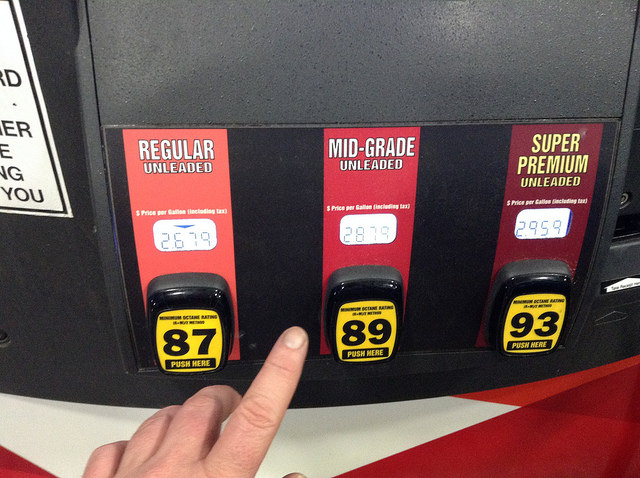Shale oil, which the Energy Information Administration projects will represent a rising proportion of American oil supplies in the coming decades, has a surprising Achilles heel: its low octane levels, which make it a poor fit for the high-efficiency car engines of the future.
For financially troubled shale drillers, that’s bad news, since it suggests demand for their oil could fall even if the price of a higher-octane oil barrel rises.
For the rest of the country, shale oil’s quality issues raise important questions about whether building infrastructure to support decades of shale oil production is smart public policy, because a shale oil boom could ironically spell higher prices at the gas pump for American drivers. Or if shale oil makes regular but not premium gas cheap, that could deter Americans from buying premium-fueled cars despite better gas mileage, undermining plans to cut tailpipe pollution by building better engines.
Automakers are increasingly interested in premium gasoline because its higher octane levels make gas less likely to prematurely combust in a high-compression engine — and if fuel ignites before it should inside a car or truck’s engine, it can make the engine run roughly or suffer damage. Car manufacturers see the promise of greater fuel efficiency in turbocharged engines, which rely on that higher compression and, in turn, on high octane premium fuels.
“IHS forecasts that turbocharged engines will represent 55 percent of production for North America by 2024, up from an expected 33 percent this year,” Automotive News reported in June 2017.
In March, Dan Nicholson, a General Motors’ vice president, even called on refiners to make premium gasoline the new standard at American gas pumps, arguing that premium’s higher octane levels allow car manufacturers to design more fuel-efficient cars and trucks.
Shale Oil’s Limitations
But shale oil, it turns out, brings with it a variety of elements that lower the octane levels of a gasoline blend, like naphtha. The ultra-light color that at first excited shale drillers — the light, sweet crude that had become harder to find from conventional sources — reflects shale oil’s higher proportions of natural gas liquids and other easy-to-ignite hydrocarbons.
“Our thesis is that the U.S. refining system is close to being maxed-out on the amount of shale oil it can process,” a Morgan Stanley research note concluded this month, citing shale oil’s light hue, which makes it ill-suited to make high octane gas, as well as jet fuel and diesel.
“The more shale oil we run, so to speak, the more difficult it is to get that high percentage octane,” Tom Kloza, Global Head of Energy Analysis at IHS‘s Oil Price Information Service, told the Energy Information Administration’s (EIA) annual conference last year. “Ironically, we’re not going to be using more fuel in the U.S. in the next 5 years, but we’ll need more octane, at least until more cars run on electricity.”
Inside a car engine’s cylinders, timing is everything. Gasoline is mixed with just the right amount of oxygen to let it ignite when each spark plug fires, timed so that the resulting explosions drive some pistons down at the same time as other pistons rise, turning the engine’s crankshaft. Early ignition can interrupt that smooth turning, causing a problem that drivers will recognize as a knock or a ping. The higher a gasoline blend’s octane levels, the less prone it is to igniting prematurely.
The difference between a gallon of regular and a gallon of premium is the gasoline’s octane levels.
Drivers can already see the impacts of the shale rush at the pump, with the difference between regular and premium prices reaching over 50 cents a gallon across the U.S. In some cities, like Chicago, where most gasoline comes from shale oil, the difference is over 75 cents a gallon. Back in 2000, the difference between regular and premium was just 18 cents a gallon.
“We’re kind of out of sources for octane, at the moment, having run the gambit of everything we can think of,” said Lynn Westfall at 2017 EIA Energy Conference during a presentation titled “Gasoline fuel quality: The looming octane shortage.”
Gasoline’s History of Octane Problems
Over the years, octane additives have caused some of the biggest environmental scandals in U.S. history. So it’s worth paying attention to the way the refining industry solves this emerging problem.
Until the 1970s gasoline-makers used lead to raise the octane levels of the gas consumers buy at the pump, but lead was taken out of gasoline formulas because it was so harmful to public health, particularly children’s health. Lead was cheap, but incredibly polluting. The impacts from leaded gasoline on public health were so profound that some researchers have connected it to the rise and fall of violent crime in the U.S., pointing out that the neurological damage connected to lead exposure leads to “aggressivity, impulsivity, ADHD, and lower IQ” and that violent crime levels both rose and fell at the same rate as lead in gasoline. Leaded gasoline was banned except in aviation fuels in the U.S. in 1996.
Refiners then turned to MTBE (methyl tertiary-butyl ether) — which seemed to work great until it turned out that MTBE gets into water supplies easily and doesn’t biodegrade quickly, and reservoirs and water wells across the U.S. were testing positive for MTBE contamination.
Fearing liability, refiners stopped using MTBE and switched to ethanol. But though the corn-based fuel is marketed as renewable, critics point to other environmental problems. “Higher-ethanol blends still produce significant levels of air pollution, reduce fuel efficiency, jack up corn and other food prices, and have been treated with skepticism by some car manufacturers for the damage they do to engines,” Yale Environment 360 reported in 2016.
Nonetheless, the ethanol industry has been pushing for a bigger role in the U.S. fuel mix and lobbying to reshape America’s fuel efficiency standards, the Corporate Average Fuel Economy (CAFE) standards, under the Trump administration. “We were very encouraged to see EPA specifically ask for comment on the ‘potential for high-octane blends’ in the notice announcing the reconsideration of the last administration’s Final Determination,” Bob Dinneen, president and CEO of the Renewable Fuels Association, an ethanol industry group, said in an October 2017 statement.
Shale to the Rescue?
The shale gas industry has also been positioning itself as the solution to shale oil’s octane problem. In 2016, the Marcellus Shale Coalition, a trade group representing the shale gas industry in Pennsylvania, Ohio, and West Virginia, joined the “High Octane Low Carbon Alliance.” Butane, a natural gas liquid produced by many “wet” shale wells, can raise octane levels — but it’s prone to evaporation, so it’s impractical to use except during cold winter months.
That leaves two possible alternatives, according to a March 2018 Oil and Gas Journal special report. But both will bring significant costs and environmental concerns of their own.
One is for refineries to build units to convert naphtha itself into an octane booster — but, the journal warns, “costs rise accordingly” and the light naphtha in shale oil is “less suited” to high-octane conversion.
The other option is what’s called “alkylation,” where powerful sulfuric or hydrofluoric acids are used to make a high-octane blend from isobutane and butylene at refineries. But “alkylation units are expensive to build, and their use of acid makes permits for these units difficult to obtain,” the journal wrote. The report pointed to a Chevron facility in Utah, where the company uses a different catalyst as a possible option.
It’s not yet clear what approach refiners will take to raising the octane levels of shale oil, or how soon electric vehicles may render shale oil’s octane problems moot.
But fundamentally, the problem is that shale oil is a different kind of crude than the oil drilled 100 years ago. Texas oilmen used to compare oil supplies to a cast-iron pot of beans cooked over a campfire, saying that conventional oil reserves are like the well-cooked beans, the first bites you’d dip your spoon into. Shale oil, by extension, is the black flaky layers at the bottom of the pot — sure you can eat them, but if you are, it’s a sign that the good stuff is already gone.
Follow the DeSmog investigative series: Finances of Fracking: Shale Industry Drills More Debt Than Profit
Main image: Gas pump Credit: Mike Mozart, CC BY 2.0
Subscribe to our newsletter
Stay up to date with DeSmog news and alerts






